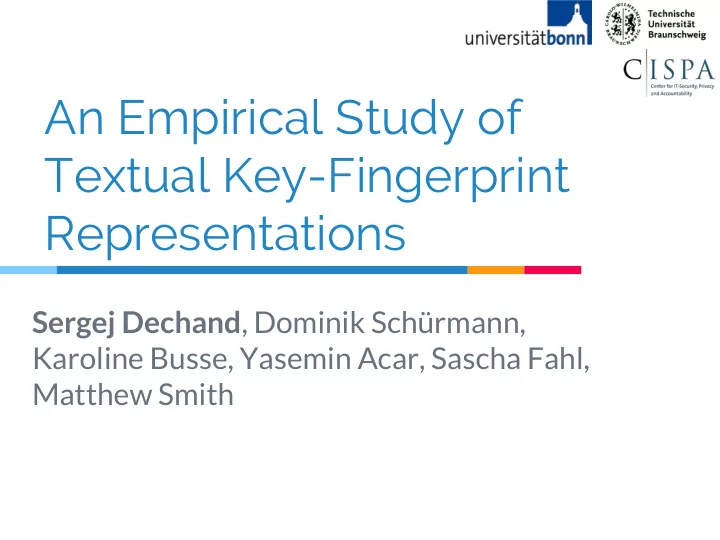

An Empirical Study of Textual Key-Fingerprint Representations Sergej Dechand , Dominik Schürmann, Karoline Busse, Yasemin Acar, Sascha Fahl, Matthew Smith
“ Title: Do Users Verify SSH Keys? Abstract: No - Peter Gutman, 2011
Key Fingerprints ▷ Mostly not checked ▷ Error prone ○ Partial preimages ○ Hard to compare ▷ Meaningless? ▷ Still relevant
Our Goal Which text representation is best? ▷ High attack detection ○ Partial preimages ○ Low false positive rate ▷ Efficient ○ Fast comparisons ○ Low cognitive load ▷ Best user perception ▷ Robust
Tested Representation Schemes ▷ Hexadecimal 18e2 55fd b51b c808 ▷ Base32 ddrf l7nv dpea ▷ Numeric 2016 507 6420 1070 ▷ PGP List locale voyager waffle disable ▷ Peerio List bates talking duke slurps ▷ Sentences That lazy snow agrees upon our tall offer
Threat Model Which attacks are feasible?
Attack Methods Ideal : Preimage for an existing key fingerprint ○ Expensive ○ Infeasible Workaround : Generate partial preimage ○ Fingerprints almost match (except of a few chars) ○ Exploit people’s attention limitations
Attacker Strength ▷ Assumptions ○ The fingerprints include key and metadata ○ New fingerprints without generating new keys ○ Only hashing needs to be performed ▷ 80 of 112 bits controlled by attacker ○ First and last few bits are controlled ▷ Still high costs to generate partial preimages ○ Although not impossible
Simulated Attacks ▷ Inverting uncontrolled bits ▷ Inversions within a logical sequence ○ Characters ○ Words ○ Digits 18e2 55fd 4ae4 c808 18e2 55fd b51b c808 601b 11a3 2d69 601b ee5c 2d69
Study Design Controlled experiment followed by a survey Conducted on MTurk
Study Design ▷ Users compare fingerprints ○ Match vs. Doesn’t match ▷ Survey with usability questions ▷ Pre-study before setting study parameters ▷ 4 tested schemes, factorial design (mixing within and between groups) ○ Hex or Base32 ○ Numeric ○ PGP or Peerio word list ○ Sentences
Experiment Task ▷ Hexadecimal ▷ Base32 ▷ Numeric ▷ OpenPGP Wordlist ▷ Big Wordlist ▷ Sentences
Study Design ▷ 40 comparisons in randomized order ○ Avoids fatigue and learning effect ○ Each scheme attacked once (randomized order) ○ Higher attack rate leads to higher detection rate ▷ Attention tests with obvious mismatches ○ Users failing the attention tests are excluded ▷ Training sets for each scheme ○ Reported typo search in language-based schemes ○ Not considered in the results
Survey ▷ Survey after finishing all tasks ○ Rating the schemes ○ Demographics
Challenges ▷ High number of participants required ○ High attack detection rate ○ Low differences between some approaches ▷ No parameter testing ○ Condition explosion if parameters are tested ○ Font settings ○ Chunking ○ Colors ▷ Additional experiment testing the chunking
Results Controlled experiment and survey
Results ▷ 1047 participants from MTurk ○ 46 excluded due to failed attention tests ○ Mixed demographics ○ No performance differences based on age, gender, education ▷ Relatively high attack detection rate for all schemes
Experiment Results Speed Undetected False (median) Attacks Positives 10s 10.44% 0.5% Hexadecimal 8.9s 8.50% 2.6% Base32 9.5s 6.34% 0.3% Numeric 11.2s 8.78% 0.5% PGP Word List 7.3s 5.75% 0.4% Peerio Word List 10.7s 2.99% 1.5% Sentences
Chunking Results Speed Undetected False (median) Attacks Positives 11.3s 8.15% 0.38% Hex 2 10.3s 6.14% 0.29% Hex 3 10.4s 6.78% 0.38% Hex 4 11.6s 7.89% 0.78% Hex 5 13.6 8.13% 0.5% Hex 8
Survey Results
Limitations ▷ No guarantee if verification is performed ▷ Validity of MTurk (as with any MTurk study) ○ More tech-savvy ○ Younger ○ Used to textual and visual tasks ▷ No tests for additional parameters due to condition explosion ○ Font settings (type, size, etc.) ○ Use of colors ○ Line break settings
Conclusion Takeaways?
Conclusion ▷ Hex has shown the worst performance ○ Lower attack detection rate ○ Slower than most approaches ○ Perceived to be more annoying ▷ Generated sentences with best results ○ Highest attack detection rate ○ Best results regarding usability ▷ Numeric best non language-based scheme
Recommend
More recommend